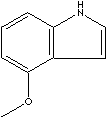PRODUCT IDENTIFICATION

H.S. CODE
TOXICITY
4-Methoxyindole; 4-Methoxy-1H-indole;
CLASSIFICATION
EXTRA NOTES
PHYSICAL AND CHEMICAL PROPERTIES
66 - 69 C
REFRACTIVE INDEX
136 C
EXTERNAL LINKS & GENERAL DESCRIPTION
Drug Information Portal (U.S. National Library of Medicine) - Methoxyindole
PubChem Compound Summary - 4-Methoxyindole
Drug Bank - 4-Methoxyindole
KEGG (Kyoto Encyclopedia of Genes and Genomes) - Methoxyindole
http://www.ebi.ac.uk/chebi/ - 4-Methoxyindole
http://www.ncbi.nlm.nih.gov/ - 4-Methoxyindole
http://www.sigmaaldrich.com/
Application:
Reactant for preparation of ·GABA analogs, ·Sodium-Dependent
Glucose Co-transporter 2 (SGLT2) Inhibitors for the Management of
Hyperglycemia in Diabetes ·Anticancer agents, ·Integrase
strand-transfer inhibitors (INSTIs), ·Inhibitor of Proliferation
of Colon Cancer Cells, ·Isomeridianin G as GSK-3ß inhibitors,
·HIV-1 integrase inhibitors, ·Inhibitors of mitogen
activated protein kinase-activated protein kinase 2 (MK-2)
Local:
Indole, benzopyrrole, is a yellow crystalline powder with unpleasant aroma. It
has the pyrrole ring (five-membered unsaturated ring structure composed of four
carbon atoms and one nitrogen atom) which is fused to benzene ring. There are
tautomerer called indolenine (unsubstituted 3H-indole) and structural isomer,
isoindole. But they are unstable. Indole occurs in some plants or in coal tar,
and is formed in the intestine during putrefaction and by certain cultures of
bacteria. it is commercially synthesized from phenylhydrazine and pyruvic acid. Indole structure is a
motif in nature. Prominent examples include tryptophan (aromatic side chain amino acid), serotonin
(neurotransmitter), auxin (plant growth hormone), and indigo (plant colorant).
One more interesting point is all these compounds have functional branches at
3
position.
Indole is used in perfumery and in preparing tryptophan, one of the 20 amino acids
commonly found in animal proteins. It has important application in the industry
of plant growth. It is used to prepare indoleacetic acid (auxin) and other
plant growth substances which help the development of roots in plant. It is used
to make selective herbicides. Indole and its derivatives are widely used in
making perfumes, dyes, agrochemicals and medicines.
APPEARANCE
98.0% min
66 - 70 C
HAZARD OVERVIEW
OSHA Hazards: Irritant
GHS
PICTOGRAMS

HAZARD STATEMENTS
H315-H319-H335
P STATEMENTS
P261-P305 + P351 + P338
![]()
RISK PHRASES
36/37/38
SAFETY PHRASES
26-36